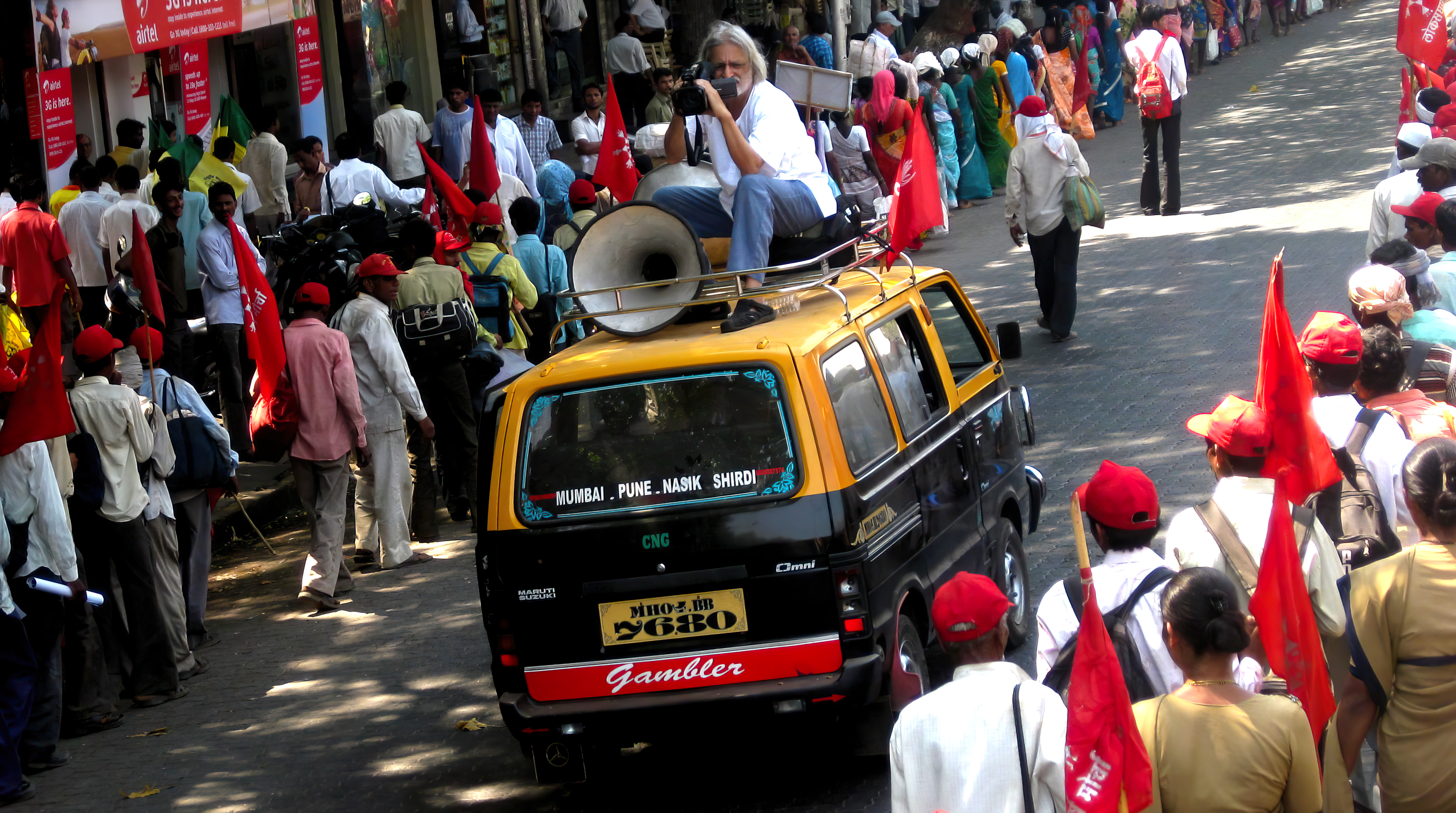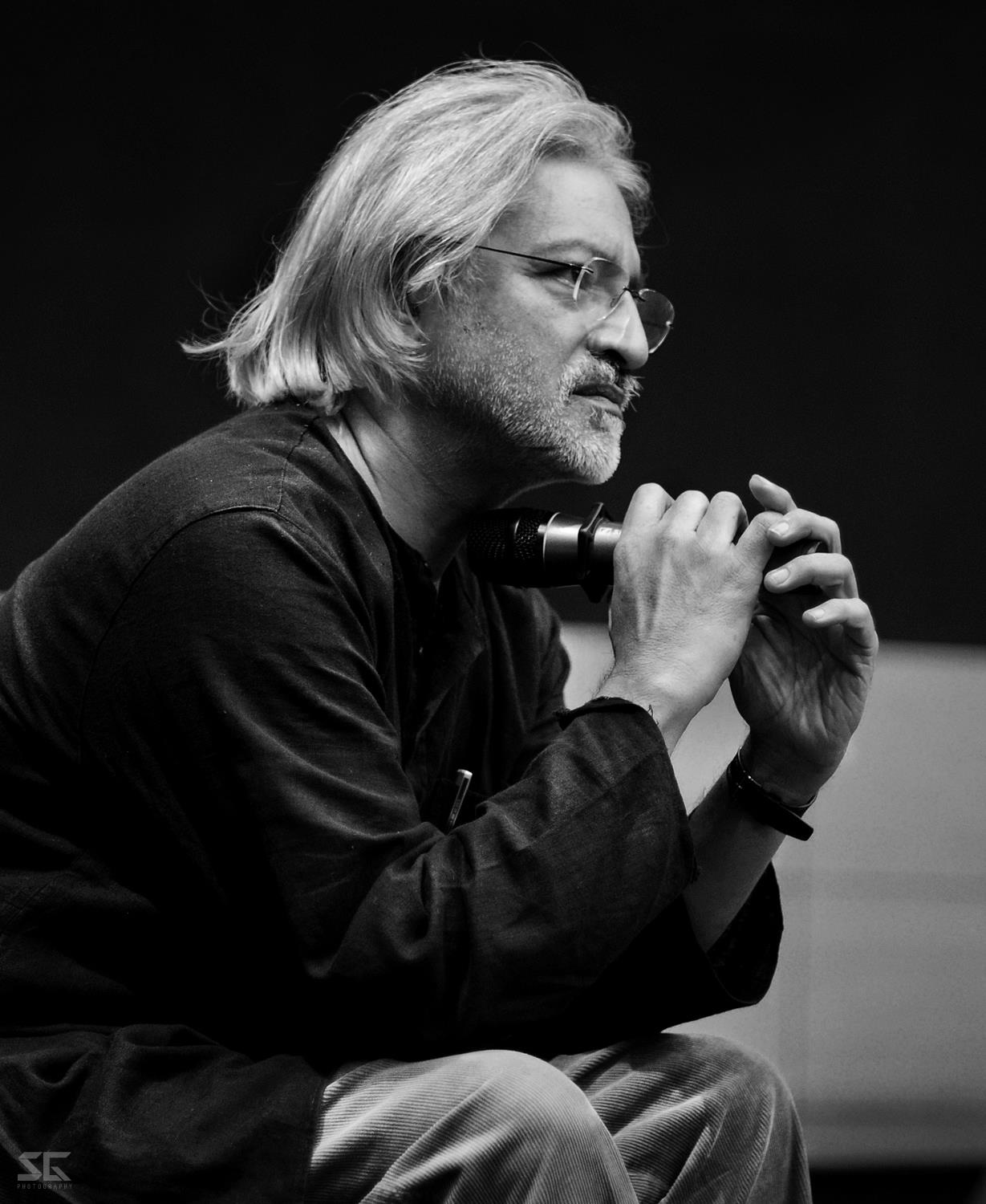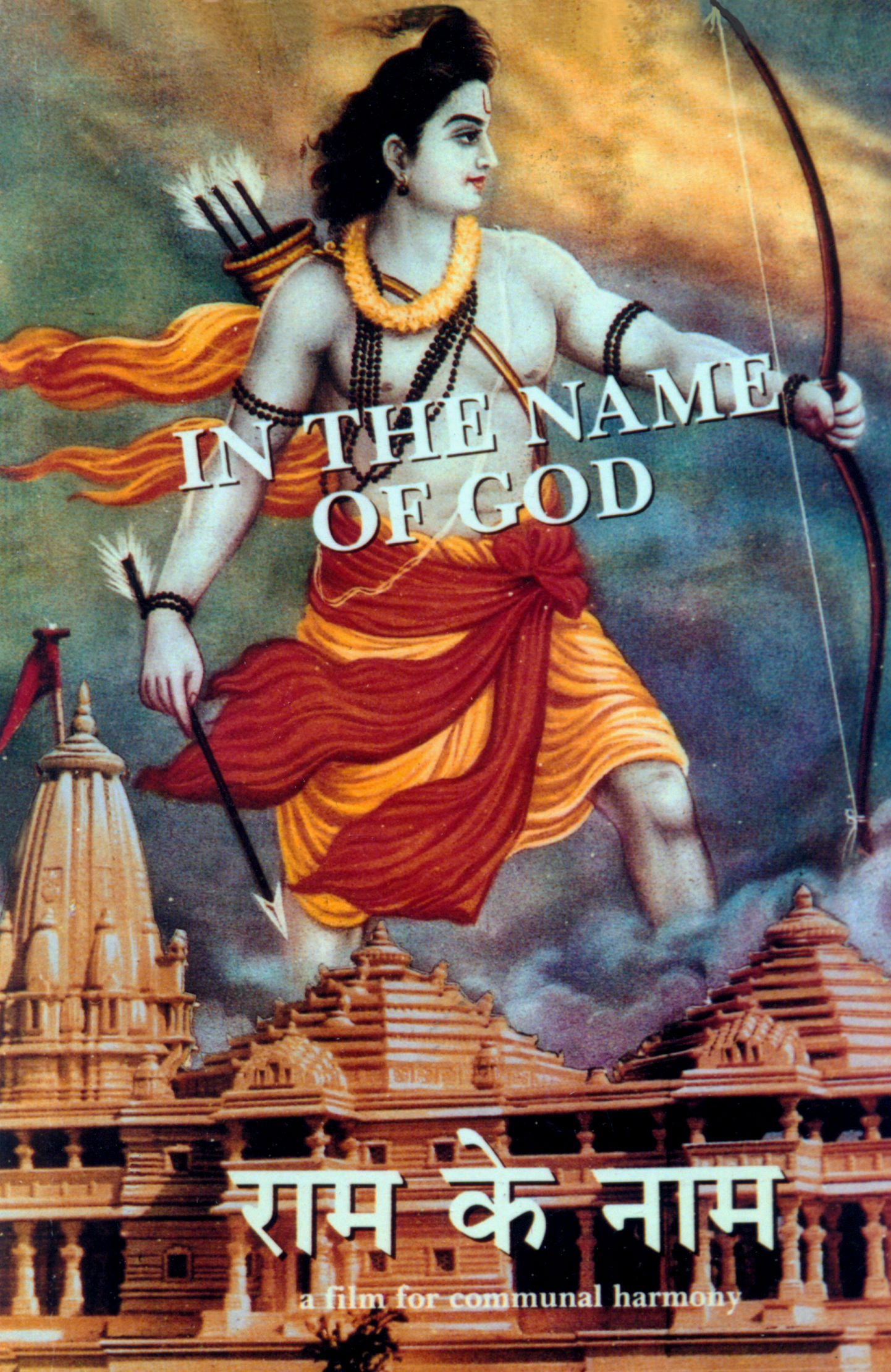 “For more than four decades,” his 2020 New York Times Magazine profile notes, Anand Patwardhan “has been India’s leading documentary filmmaker.” X-rays of Indian modernity, his frequently expressionistic films tug at the frayed edges of an unraveling nation to reveal the threads—of class inequity, casteism, masculinity, religious fundamentalism, and nationalism—that warp and weft through the fabric of what the ruling Bharatiya Janata Party calls the New India.
“For more than four decades,” his 2020 New York Times Magazine profile notes, Anand Patwardhan “has been India’s leading documentary filmmaker.” X-rays of Indian modernity, his frequently expressionistic films tug at the frayed edges of an unraveling nation to reveal the threads—of class inequity, casteism, masculinity, religious fundamentalism, and nationalism—that warp and weft through the fabric of what the ruling Bharatiya Janata Party calls the New India.
Among other things, Patwardhan has documented a non-violent mass uprising in 1974 that led to the Emergency (Waves of Revolution); charted the struggles of slum dwellers (Bombay, Our City) and millworkers (Occupation: Millworker); and exposed India’s cascading descent into majoritarianism and Hindutva hell (In the Name of God; Father, Son and Holy War; Reason). In the process, his films have also excavated subaltern and counter strains of hope and resistance with compassion and, often, even humor.
Documentary spoke to Patwardhan via email prior to his keynote address at IDA’s Getting Real ’22 conference in September.
DOCUMENTARY: As a documentarian and chronicler of the many violent neuroses of modern India, how do you explain the bipolarity of a state that has, on the one hand, awarded you National Awards, and yet, on the other, hindered your work at every turn?
ANAND PATWARDHAN: What you describe as bipolarity applied from the 1970s when I began to make films, but before this was a more fluid and hopeful period in the aftermath of India’s Independence. Let us call it a period of some grace, where the leading contenders were Gandhians, Socialists, Ambedkarites, and Communists—i.e., believers in secularism and egalitarianism on one side–and an emerging capitalist class that wanted a “free” economy on the other.
The extreme right, led by Brahminic forces and the former princely classes, had made themselves deeply unpopular by killing Mahatma Gandhi, and their two organizations—the RSS (Rashtriya Swayamsevak Sangh) and the Hindu Mahasabha—had gone underground after being briefly banned for Gandhi’s murder. Even the emerging capitalist class had to be subservient to Nehruvian ideas of a planned economy. Politically, a non-aligned India balanced itself between the US and the Soviet Union, and internally between a public sector and a private sector. Hope was palpable. You can trace this hope even in the literature and cinema of the times. Look at Premchand pre-Independence, writers like Amrita Pritam whom he inspired generations later, or the films of Mehboob Khan, Shantaram, K.A. Abbas, and so many others.
Economically speaking, this period came to an end when the US and its allies won the Cold War, destroying the Soviet Bloc, demonizing the very concept of socialism, and then, through instruments like the World Bank and the International Monetary Fund, gradually taking global control in what is euphemistically described as “liberalization.”

D: How did this play into your filmmaking?
AP: My filmmaking began at the cusp between these two periods, and so did this bipolarity you describe, of attracting censorship as well as winning national awards. The awards further enabled me to win court cases ordering Doordarshan [the government-run national broadcaster] to screen my films on national TV. This period even included a brief BJP-ruled interlude when they were still hesitant and had not consolidated a brute majority. Paying lip service to secular constitutional values meant that the government could still be embarrassed both by national and international criticism. Narendra Modi, then Chief Minister of Gujarat, was actually denied a US visa for crimes of omission and commission during an anti-Muslim pogrom in Gujarat in 2002.
D: I have read elsewhere that you became an activist after you went to Brandeis. How did that happen?
AP: Very briefly, I grew up with freedom fighters on both sides of my family who had fought against British Rule. Yet this seemed to have no direct bearing on me as a young college-going kid until I went to Brandeis on a scholarship. That was during the Vietnam War and America was in the midst of the counterculture. Anti-war protests, the Black Panthers, Cesar Chavez, and the United Farmworkers Union were all part of my growing-up process. I spent six months in California helping the Union with its boycotts and strikes and also campaigning for George McGovern, whom the UFW had backed against Richard Nixon. When I returned to India I worked for two years as a volunteer in a rural education and development project. By 1974, I had joined a mass movement in Bihar, which eventually led to a State of Emergency being declared across India.
D: Do you think India is going through an undeclared Emergency now?
AP: Absolutely, though few seem to be aware of it. The corporate class is in partnership with multinational forces to underplay the dangers that are brewing. So well hidden is the manufacturing of consent that only those directly impacted by murder, incarceration or censorship are aware that such an Emergency exists.
D: Laurie Anderson recently lamented that "reality itself has become political and debatable.” In a post-truth world, what is the role of the documentary?
AP: I find the idea of "post-truth" disconcerting. It's one thing to point out that people from a whole generation have been fed fake news and false narratives, but it is quite another to say that one can never discover the truth or any approximation of it. Worst is to say that there is no such thing as truth and all claims to it are false by definition.
As for the “truth” of documentary footage, this can no longer be taken for granted, thanks to AI and the increasing technical possibilities of making something artificially created look real. The truth of a documentary film then depends on many factors and not just on the look of a particular shot. Usually, with experience, one can discern when a sequence has been artificially created or whether a film as a whole has integrity. I would argue that in what you describe as a “post-truth world,” there is even greater need for a documentary film that bears witness to events as they unfold or analyzes these events from points of view that are not pre-digested or pre-paid for.

D: Adam Curtis recently said, "Our time feels unreal because so many of the things that we know are important have become invisible to us...like the big forces around us, like modern global finance, computer systems, and even nuclear science...the way they work, you can't see them.... If you want to make a film about computers, or finance, or nuclear science, there's absolutely nothing to film." Do you agree, and do you think your work might be seen as making invisible things visible (like the threads connecting nuclear testing, nationalism and masculinity that you trace in War and Peace, for instance)?
AP: True, indeed. If one wants to film something like the military-industrial complex, direct access is completely denied. Forget authoritarian India; even in the US, people were denied the possibility of seeing what weapons of mass destruction like the atom bomb had done on the ground. The bombs over Hiroshima and Nagasaki were shown dropping from a distance, but the images at ground level of what these had done to human beings were virtually denied to the American public for decades. The same written or unwritten rule was in place even decades later when the Gulf War and later the “Shock and Awe” bombing of Baghdad in 2003 flashed across TV screens like a video game, while the damage on the ground was rarely filmed or air-brushed to avoid the blood and gore.
While making War and Peace, I interviewed researchers and curators of an exhibit that had been planned at the Smithsonian Museum in Washington, DC to mark the 50th anniversary of the dropping of the atom bombs on Japan. Towards the end of World War Two, Japanese warships were already at the bottom of the sea. America had cracked the Japanese secret code and knew that the Japanese Emperor wanted to surrender. This had been conveyed by telegrams to the US President. The proposed Smithsonian exhibit included large reproductions of these telegrams, proving what USA knew before the atomic bombings. So the later justification—that Hiroshima and Nagasaki were flattened in order to end the war, thus saving a million American lives—was false. Such facts were kept from the American public even 50 years after the war had ended.
D: How does the Indian state manufacture consent today? Do you think the state's use of coercion and control and its willingness to weaponize its repressive apparatuses have fundamentally changed with the gradual legitimization of the BJP government? As an activist filmmaker, how has the filmmaking experience in India changed for you over the years?
AP: The manufacturing of consent has reached unprecedented levels in India under Modi. Partly this is a function of technological “progress” and global equations, and partly it is due to the tried-and-tested tactic of demonizing a single community. What Hitler did to the Jews is being done to Muslims in India, although at this point in time we are early in the game.
Apart from individual murders in the name of the cow or any other form of demonization, in [the north-eastern state of] Assam they have already constructed what can only be described as “concentration camps” for those who are unable to find or buy the correct batch of citizenship papers. There is no mass genocide yet, but the kind of hate that is openly propagated and officially sanctioned makes me fearful of what can happen.
![]()
D: You mentioned technological “progress” aiding this…
AP: Technology helps, with cheap cell phones that carry fake news to all. The geopolitical situation is also very different today from what it used to be. During the Cold War, America saw Pakistan as its natural ally; India was seen as either non-aligned or in the Soviet camp. America used Pakistan as a launch pad to spread Islamic jihad against godless communists in Afghanistan and the Soviet Union. With the defeat of communism, Islamic jihad—once the chosen ally against communism—became the main global enemy itself.
That was cause enough for the much-touted love affair between Narendra Modi and Donald Trump (remember, Trump’s adapted Hindi election slogan to woo Indian Americans, “Abki Baar Trump Sarkar”—This Time A Trump Government—was borrowed from Modi’s election campaign). Trump’s MAGA (Make America Great Again) mirrored an old RSS wet dream we may as well call MIGA (Make India Great Again). The American obsession with “Old Glory” (the stars and stripes flag) is today mirroring in India as the RSS/Modi combine launches a national drive called “Har Ghar Tiranga” (A Tricolor national flag in every home).
Today, India has replaced Pakistan as America’s natural ally, this time against China, and while Modi-Biden may not be a love affair, it is still a marriage that prevents the world from speaking out against India’s majoritarian drift.
To come back to your documentary question, as a filmmaker I have always had to operate on the margins. Until the fairly recent past, I traveled widely across India, film and projector in tow, doing community screenings. Today, that has become much more difficult. Public screenings are fewer and audiences smaller in size because we have to be more careful about spreading the word. As for TV, in the past I went to court, won every time, and six of my films were broadcast, a few at prime time. Even though once the court order of a single screening had been obeyed, the films never aired again on TV. But even single airings had a formidable impact. I still meet people who describe how an accidental viewing of TV in their youth shaped their mode of questioning.
Of course, the objective truth is that the viewership of my films never reached any kind of critical mass. Today’s India is ample proof of the ineffectiveness of all our collective efforts from the margins.
D: Immersed as we are in Big Tech algorithms, the immediacy of social media, and the 24/7 "breaking news" cycle, do you think it's getting harder for people to access, absorb and process more rigorous works of art (such as some of your own often difficult-to-watch films, or a documentary series like Raoul Peck's Exterminate All the Brutes)?
AP: Of course! Audience attention spans are no longer what they used to be, and the younger generation fails to watch and absorb anything over a few minutes long. But more tellingly, there are no platforms where you can position a longer, more serious piece, and expect people to access it.
More than the issue of its pure entertainment value is the issue of political censorship. Platforms like Netflix and Amazon have told me to my face that they would be thrown out of India if they showed anything close to the content and treatment that my films regularly contain.
Even supposedly non-commercial internet options like YouTube and Facebook indulge in a kind of backdoor censorship, at least in India. On YouTube I suddenly find laughable “copyright” claims made on material that I had personally filmed, or on music rights that I had cleared, or else somebody on YouTube suddenly deems a particular film of mine “for adults only,” even though the same film has won a “Universal” certificate after hard-fought battles with the Central Board of Film Certification.
With Facebook, the censorship is slightly more subtle. Here I am not even referring to the occasional audio-visual material I post, but to text. About a decade ago, texts I posted were read by 60,000 to 70,000 people per post. Today this has come down, on a good day and on an important post, to 1,000. This certainly does not indicate that suddenly no one is interested. It is a kind of internal manipulation by Facebook that determines what posts are read by whom. Instead of allowing posts to circulate without intervention, Facebook ensures that you only reach the like-minded and not too many of them.
D: You recently said, "I’m always optimistic. Not as a political choice, but because it’s a form of survival." With multiple crisis-level breakdowns in India and globally, what gives you hope? Are you ever tempted to give up?
AP: Giving up is suicide. Watching everything without saying a word is neither desirable nor doable. That I am far from being alone is the hope. Many people I admire have died for their beliefs, Mahatma Gandhi being the most famous of them. Many of my friends are in jail as we speak, for believing in a just, secular and democratic India. What right do I, as a privileged Indian, have to give up?
Sudipto Sanyal is a writer in Kolkata. His work has appeared in The Economist, The Smart Set, The Hindu, Mekong Review, et al. He hosts a midnight show called Songs of Comfort for Hypochondriacs and Panicking Lovers, on Radio Quarantine Kolkata.




